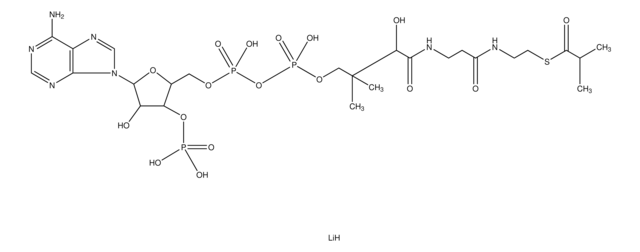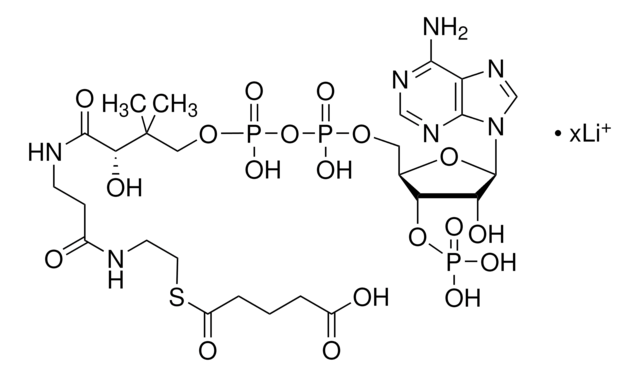I9381
Isovaleryl coenzyme A lithium salt hydrate
≥90%
Synonym(s):
IV-CoA
About This Item
Recommended Products
Assay
≥90%
storage temp.
−20°C
SMILES string
[Li+].[Li+].[Li+].[H]O[H].CC(C)CC(=O)SCCNC(=O)CCNC(=O)[C@H](O)C(C)(C)COP([O-])(=O)OP([O-])(=O)OC[C@H]1O[C@H]([C@H](O)[C@@H]1OP(O)([O-])=O)n2cnc3c(N)ncnc23
InChI
1S/C26H44N7O17P3S.3Li.H2O/c1-14(2)9-17(35)54-8-7-28-16(34)5-6-29-24(38)21(37)26(3,4)11-47-53(44,45)50-52(42,43)46-10-15-20(49-51(39,40)41)19(36)25(48-15)33-13-32-18-22(27)30-12-31-23(18)33;;;;/h12-15,19-21,25,36-37H,5-11H2,1-4H3,(H,28,34)(H,29,38)(H,42,43)(H,44,45)(H2,27,30,31)(H2,39,40,41);;;;1H2/q;3*+1;/p-3/t15-,19-,20-,21+,25-;;;;/m1..../s1
InChI key
RABPIYFVNICBEC-YVBWDKSKSA-K
Related Categories
General description
Application
- as substrate for β-Hydroxy-β-methylbutyric acid synthesis in cell-free extracts from G. reessii
- in high-performance liquid chromatography (HPLC) for the characterization of IV-CoA from lymphocytes
- as a substrate in isovaleryl-CoA dehydrogenase assay
Storage Class Code
11 - Combustible Solids
WGK
WGK 3
Flash Point(F)
Not applicable
Flash Point(C)
Not applicable
Personal Protective Equipment
Certificates of Analysis (COA)
Search for Certificates of Analysis (COA) by entering the products Lot/Batch Number. Lot and Batch Numbers can be found on a product’s label following the words ‘Lot’ or ‘Batch’.
Already Own This Product?
Find documentation for the products that you have recently purchased in the Document Library.
Customers Also Viewed
Our team of scientists has experience in all areas of research including Life Science, Material Science, Chemical Synthesis, Chromatography, Analytical and many others.
Contact Technical Service














